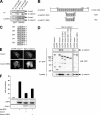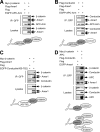Structural and functional characterization of the Wnt inhibitor APC membrane recruitment 1 (Amer1)
- PMID: 21498506
- PMCID: PMC3103299
- DOI: 10.1074/jbc.M111.224881
Structural and functional characterization of the Wnt inhibitor APC membrane recruitment 1 (Amer1)
Abstract
Amer1/WTX binds to the tumor suppressor adenomatous polyposis coli and acts as an inhibitor of Wnt signaling by inducing β-catenin degradation. We show here that Amer1 directly interacts with the armadillo repeats of β-catenin via a domain consisting of repeated arginine-glutamic acid-alanine (REA) motifs, and that Amer1 assembles the β-catenin destruction complex at the plasma membrane by recruiting β-catenin, adenomatous polyposis coli, and Axin/Conductin. Deletion or specific mutations of the membrane binding domain of Amer1 abolish its membrane localization and abrogate negative control of Wnt signaling, which can be restored by artificial targeting of Amer1 to the plasma membrane. In line, a natural splice variant of Amer1 lacking the plasma membrane localization domain is deficient for Wnt inhibition. Knockdown of Amer1 leads to the activation of Wnt target genes, preferentially in dense compared with sparse cell cultures, suggesting that Amer1 function is regulated by cell contacts. Amer1 stabilizes Axin and counteracts Wnt-induced degradation of Axin, which requires membrane localization of Amer1. The data suggest that Amer1 exerts its negative regulatory role in Wnt signaling by acting as a scaffold protein for the β-catenin destruction complex and promoting stabilization of Axin at the plasma membrane.
Figures






References
Publication types
MeSH terms
Substances
LinkOut - more resources
Full Text Sources
Molecular Biology Databases

